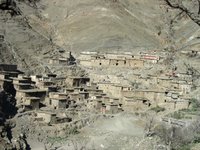
After a 10 hr bus trip yesterday through the Atlas Mountains with countless switch-backs, we arrived at our training site where we’ll be for a few weeks. The landscape here is arid with few trees, flat, with terra cotta buildings stacked tightly together in the community. There is always construction going on, like the other Moroccan towns we’ve been in and passed through, reminding you of home and that progress defined by one’s own cultural is a universal element of all people.
On yesterday, our trip through the Atlas was the most exciting moment since I’ve been here. Climbing and descending through the mountains probably took 3-4 hours and made at least one person sick. The view was breathtaking, many of the small, complex communities were intimate, and the paved road we took that was shared with other buses, small cars, and desert SUVs seemed intrusive. The road was narrow with barely enough room for two cars to pass, and their were many times that I felt our bus could just tumble off the edge and go rolling down a 70-80 degree, 200 ft embankment.
The Berbers, whose communities in Morocco began once you ascend into the Atlas and where we presently reside opposite side in the arid flatlands, make up over 40% of the states population, although for a long time they were not officially recognized. They have two languages, which now escape me, and their roots in the area known as the Maghreb (Morocco, Algeria, Tunisia, and Libya) can be traced back to 10,000 B.C. This has been verified by archaeological finds in primitive agricultural settlements and encampments alongside ancient lakes. Later, the native Berber tribes (comes from the Greek “barbarian” and still maintains that derogatory sense in Arabic today) entered written history through trading with the Phoenicians around 1300 BC (Rogerson 2005).
Berber culture seems fascinating and is user-friendly, meaning they seem very welcoming to strangers that impose upon them. In a cultural sense, the Berber can be juxtaposed with the Aymara Indians of Peru and Bolivia in S. America. Both groups were able to protect their cultural identity in highland, mountainous regions while those living geographically below them in the lowlands were often conquered, converted, and forcibly assimilated into the dominant, foreign cultures of the Inca, Spanish and Portuguese and for the Berber, the Romans, Moors, and French. The Berber also seem comparable to North American Indians in more than the fact that they arrived in Africa and American at relatively the same time. I’ll probably write more about their similarities in the future.
Some of the Berber settlements are also reminiscent of the Pueblo Indians in the southwest U.S. in that they are built into the side of the mountains, although many are built on leveled off flat areas. They are small terra cotta buildings, although some seem made with a more simple clay and the villages that I saw ranged in size from 10-200 houses.

3 comments:
Z..am enjoying you pictures and the camera is doing an excellent job for a novice user. Mom and I plan to print out all of the pictures so we can all enjoy them for a long time...Must be fantastic scenery, even in the most barren of mountain passed..take care..dad..
Z will try to get cyper hip here. Just started reading your blog and am finding it very interesting and surprised at how literate you are and the excellent way you have with words. reminds me of a future great author. love the photos and will try to keep up with your travels. some nice looking young ladies with you. be safe and have fun. stay out of the casbahs. remind me to tell you about uncle bill sometime and the casbahs. bev
Just wanted to note that Amazigh history in Morocco dates back 15,000 years, and there are more than two dialects...Tachelheit and Tamazight are the main ones, but there's also Riffi in the North, Soussi around Agadir, etc...
Post a Comment